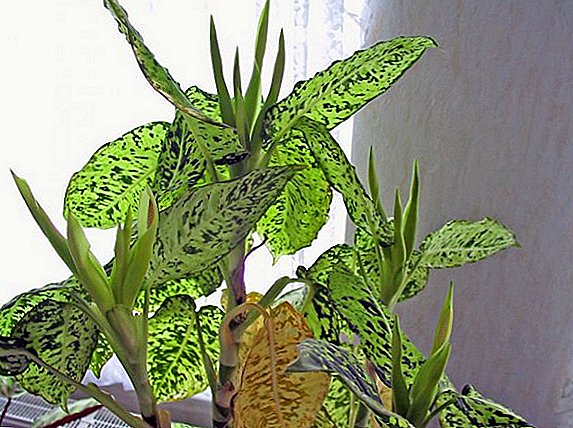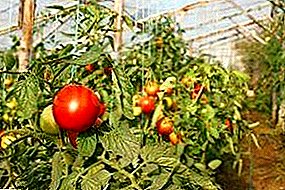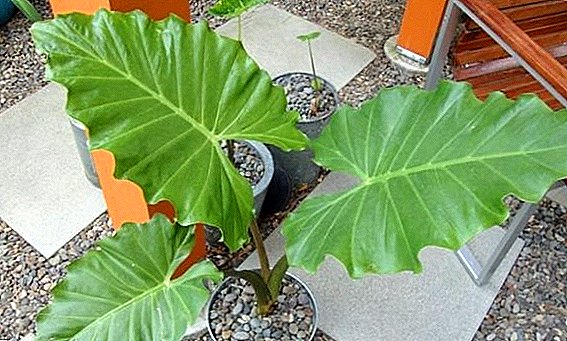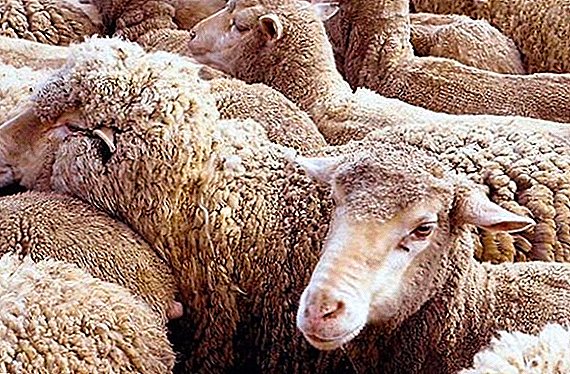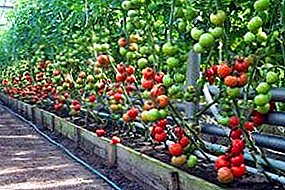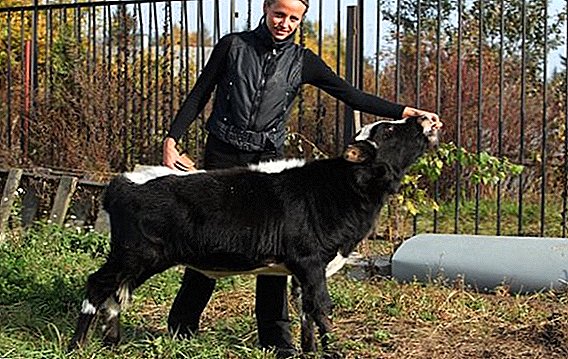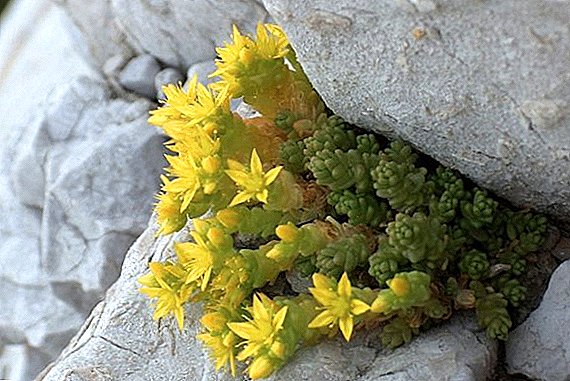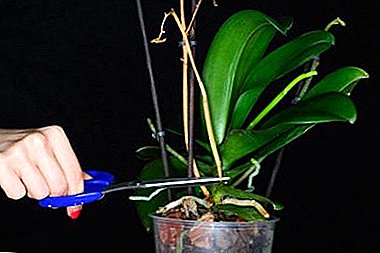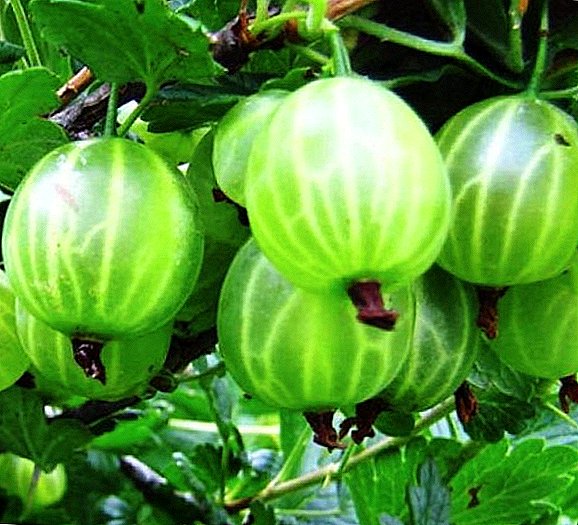 Despite the already existing large number of gooseberry varieties, breeders continue to work hard to improve the characteristics of the crop. Some of the gardeners in a hurry to buy a new product, and someone trusts the time-tested varieties. One of the well-known varieties gooseberry - Malachite, about him and will be discussed today.
Despite the already existing large number of gooseberry varieties, breeders continue to work hard to improve the characteristics of the crop. Some of the gardeners in a hurry to buy a new product, and someone trusts the time-tested varieties. One of the well-known varieties gooseberry - Malachite, about him and will be discussed today.
History of breeding varieties
In the Russian city of Michurinsk in the All-Russian Research Institute of Horticulture. Michurin under the authorship of Sergeeva was bred by crossing varieties Phenicus and Black Negus a new sort of Malachite. In 1949 an application for testing a variety was submitted to the State Committee of the RSFSR for the testing and protection of breeding achievements. And in 1959, the variety was allowed to grow, regions were recommended, among which are the Lower Volga, Ural and Far Eastern.
Description of the bush
Gooseberry bush Malachite dense, with a wide crown, tall (up to one and a half meters high). Thickly woody branches intertwine with each other, young branches are curved, with green bark, without edge. The spines are single, but there are also double ones, located perpendicular to the position of the branch, in the thorns and the internode.  On the shoots, spikes of medium length and thickness, in the internodes - smaller and thinner, they grow infrequently, therefore the bush is considered medium-rich. Emerald green foliage, rounded shape, with a smooth carved edge of the plate, the upper part is smooth, the lower one is pubescent. The blades of the sheet are veined.
On the shoots, spikes of medium length and thickness, in the internodes - smaller and thinner, they grow infrequently, therefore the bush is considered medium-rich. Emerald green foliage, rounded shape, with a smooth carved edge of the plate, the upper part is smooth, the lower one is pubescent. The blades of the sheet are veined.
You might be interested to read about gooseberry pinless varieties.
Description of berries
Large round berries, ripening, are gaining weight up to six grams. The edge of the skin is absent, the skin is covered with a touch of wax. The color of the fruit corresponds to the name of the variety - malachite-green. Because of the thin skin, littered with brighter than the basic background, veined, the berry seems translucent.
The berry is kept on a thin, rather long stem of a darker shade. The fruit contains many small seeds. Gooseberry has a bright berry smell; on a 5-point scale, its taste is estimated at 3.7 points: pleasant, refreshing, and sour. 
We advise you to familiarize yourself with the agricultural technology of cultivation of such varieties of gooseberry, such as: "Grushenka", "Kolobok" and "Komandor".
Characteristics of a variety
Malachite is unpretentious and has good characteristics, for which many gardeners and summer residents appreciate it.
Disease and Pest Resistance
According to the findings of the State Commission, Malachite has resistance to powdery mildew, is moderately resistant to anthracnose, and is practically not subject to attacks by sawflies and firefighting. It is not immune to rust and Septoria, it may be affected by other pests.
Therefore, preventive measures - treatment with fungicides and insecticides, timely cutting and care of the soil - are vital for the plant.
Drought resistance and winter hardiness
Gooseberry is not afraid of a sharp change in temperature, minus marks on the thermometer are not afraid of him. The variety was bred for growing in cold and long winters. However, such regions do not differ and are particularly hot in summer; therefore, the plant does not tolerate drought too well. In the summer he needs abundant watering. 
Gestation period
Malachite is distinguished by medium early ripening: in May it blooms, the ripening of berries begins in late June, and in late July they harvest. The bush bears fruit unevenly and for a long time, so you can take more than one crop, but if you don’t take the fruit right away, but give it a little “reach”, they will get a golden hue and a great sweetness in taste.
See also other fruit shrubs: algae algae, goji, grapes, raspberries, currants, sea buckthorn, sunberry and dog rose.
Yield
Gooseberry self-fruiting, begins to bear fruit two years after planting. The first harvest is not too great, but in the following years they harvest up to four kilograms from a bush. Fruiting lasts up to fifteen years, with proper care for the gooseberry yield almost does not decrease.
Transportability
The gooseberry peel, despite its fineness, is strong and dense. Berries without damage can be transported over long distances, with no loss of appearance or taste.
Growing conditions
For planting Malachite should pick a lit place, as well as take into account the proximity of fruit trees, which crown can cover the sun gooseberry. Variety is resistant to weather changes and winds, but still it is desirable shelter from drafts.  Undesirable location of groundwater and planting in the lowlands is undesirable; this can provoke fungal diseases. The occurrence of groundwater should be no closer than one and a half meters to the surface, the site is better flat or slightly elevated.
Undesirable location of groundwater and planting in the lowlands is undesirable; this can provoke fungal diseases. The occurrence of groundwater should be no closer than one and a half meters to the surface, the site is better flat or slightly elevated.
Gooseberry loves a clean, well-groomed soil without the remnants of weeds, with a slightly acid or neutral reaction. The soil should be well aerated; preference is given to black soil or loam.
Did you know? At the time of Tsar Ivan III, on the banks of the Moscow River there were gardens in which gooseberries were grown. And the old Russian berry was called "bersen", hence the name Bersenevskaya embankment.
Time and landing scheme
Gooseberries are planted in spring and autumn, but the latter is preferable: the shoots planted in September will have time to root and grow strong before the onset of cold weather. Planted in cleaned from the remnants of wheat grass and other weeds in the ground. The distance between the bushes, given their spreading, is not less than a meter.
The hole is dug about 40 cm deep, the same in width. Gooseberry loves fertilizers, so before each planting we should put a nutritious mixture of rotted manure and wood ash (10 kg manure / 100 g ash) in each hole. If the quality of the soil is low, you can add 50 grams of superphosphate.  The seedling is lowered into the hole at a small angle, covered with soil, lightly tamped down, then poured with water (about a bucket on a bush).
The seedling is lowered into the hole at a small angle, covered with soil, lightly tamped down, then poured with water (about a bucket on a bush).
Basics of seasonal care
Caring for shrubs - the key to a good harvest. Timely cleaning of the soil and pruning will save the gooseberry from insects and diseases, and weeding will not allow the parasites to plant nutrients, depriving the culture.
Soil care
Watering is especially required in hot weather, it is carried out under a bush. Watering should be as the soil dries, so as not to overwet the soil. It is important to monitor watering at the time of formation of ovaries, young branches, during the emergence and ripening of berries.
Important! With a lack of water, the fruits of the gooseberry are collected acids and do not get in weight.
The soil in the tree wheel must be loosened in order to oxygenate the root system of the plant, but this should be done carefully so as not to damage the surface processes of the roots.
Weeding is necessary for the plant: weeds deprive the gooseberry with moisture and nutrients. In addition, weeds grow, creating thickening, and this is the risk of bacterial diseases.
In order not to worry about a sufficient level of moisture or the formation of a hard crust in a circle around the trunk, the soil around the bush is covered with mulch, under which moisture is perfectly preserved and the growth of weeds is restrained.
Top dressing
The quantity and quality of the crop is affected by the nutrition provided to the crop during growth and maturation. In the spring gooseberry needs nitrogen, which helps build up its green mass (urea 45 g, ammonium nitrate 60 g under a bush).  When the buds begin to form, they spend the second feeding with phosphorus, it is enough to add 60 g of superphosphate under the bush.
When the buds begin to form, they spend the second feeding with phosphorus, it is enough to add 60 g of superphosphate under the bush.
In the fall, after harvesting, potash-phosphate fertilizers are applied, which will strengthen the root system and the wood of the plant for the winter. Two tablespoons of superphosphate and potassium chloride are introduced under the shrub.
Cropping and crown formation
The first pruning procedure is carried out immediately after planting: shorten the shoots, leaving about six buds. The next sanitary pruning is carried out before the movement of the juices and the swelling of the kidneys.
In the autumn period, old and damaged branches are removed, shoots growing inside the crown, and preventing the growth of other branches. You should avoid thickening the bush, so as not to provoke disease and the invasion of insect pests. Sanitary autumn pruning as the bush grows involves removing the tops of the shoots, on which the berries are crushed, removing five-year branches. 
Important! After pruning, all cuts must be treated with garden pitch to prevent infection.
Preparing for the winter
In addition to the autumn pruning, the winter preparation process includes cleaning of the tree circle from fallen leaves, branches and other debris. Only the most fertile branches (about five) are left for winter, the rest are cut to the soil surface.
Pristvolny circle mulch peat, sawdust, humus. After the snow falls, a snow layer is pushed under each bush. If there is little rain, cover with special material (agrospan).
Gooseberry Use
The sweet and sour taste of berries determines a wide range of their use in cooking. Berries are eaten fresh, prepare fruit and fruit-vegetable salads. In the winter gooseberries roll compote, jam, jam, jam, berries and freeze.
Fruits are used as a filling for pies, boiled syrups and toppings, cooked marshmallow, marmalade, jelly, refreshing fruit drinks, berries are decorated with desserts. An unusually piquant touch of meat dishes, fish, poultry and garnish give gooseberry sauces. Berry is popular in the preparation of domestic alcoholic beverages: liqueur, wine, liqueur. 
The advantages and disadvantages of the variety
The advantages of the variety:
- high yield;
- preservation of fruits during transportation;
- the duration of fruiting;
- large selection in the application of fruits;
- pleasant taste and aroma;
- the size of the fruit;
- lack of shedding berries when ripe;
- powdery mildew resistance;
- high resistance to low temperatures.
Did you know? Green gooseberry, due to its high pectin content, is recommended for people involved in hazardous production. Substances bind and excrete toxins, salts of heavy metals, level radiation exposure.
Disadvantages:
- reduced immunity to anthracnose and rust;
- tendency to weave shoots.
In general, reviews of gardeners Malachite grade positive. The culture can be grown in cold winters, with proper care the bush bears fruit for a long time, the berries have a beautiful presentation and a good size. The gooseberry, besides, is a useful culture, there is a lot of iron in it, ascorbic acid, it is low-calorie, which makes it possible for berries to be consumed by people with excess weight.


